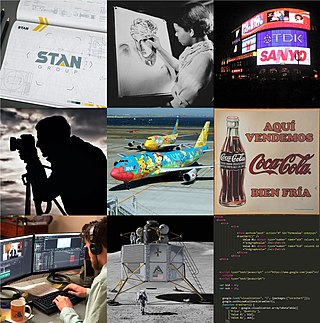
Graphic design is a profession, academic discipline and applied art whose activity consists in projecting visual communications intended to transmit specific messages to social groups, with specific objectives. Graphic design is an interdisciplinary branch of design and of the fine arts. Its practice involves creativity, innovation and lateral thinking using manual or digital tools, where it is usual to use text and graphics to communicate visually.

A category of fine art, graphic art covers a broad range of visual artistic expression, typically two-dimensional, i.e. produced on a flat surface. The term usually refers to the arts that rely more on line, color or tone, especially drawing and the various forms of engraving; it is sometimes understood to refer specifically to printmaking processes, such as line engraving, aquatint, drypoint, etching, mezzotint, monotype, lithography, and screen printing. Graphic art mostly includes calligraphy, photography, painting, typography, computer graphics, and bindery. It also encompasses drawn plans and layouts for interior and architectural designs.
A creative director is a person who makes high-level creative decisions; oversees the creation of creative assets such as advertisements, products, events, or logos ; and directs & translates the creative peoples who produce the end results. Creative director positions are often found within the television production, graphic design, film, music, video game, fashion, advertising, media, or entertainment industries, but may be found in other creative organizations such as web development and software development firms as well.

Motion graphic design, also known as motion design, is a subset of graphic design which combines design with animation and/or filmmaking, video production, and filmic techniques. Examples include kinetic typography and graphics used in film and television opening sequences, and station identification logos of some television channels.
Graphic design careers include creative director, art director, art production manager, brand identity developer, illustrator and layout artist.
Mel Byars, is an American design historian.
Roger Fawcett-Tang is a British graphic designer with a special interest in book design and calendars. He has written several books about design.

Interactive design is a user-oriented field of study that focuses on meaningful communication using media to create products through cyclical and collaborative processes between people and technology. Successful interactive designs have simple, clearly defined goals, a strong purpose and intuitive screen interface.

Steven Heller is an American art director, journalist, critic, author, and editor who specializes in topics related to graphic design.

Nick Shinn is a typeface designer. He attended Bedford School then Leeds Polytechnic, where he earned a Dip. AD in Fine Art.

Fashion illustration is the art of communicating fashion ideas in a visual form through the use of drawing tools or design-based software programs. It is mainly used by fashion designers to brainstorm their ideas on paper or digitally. Fashion illustration plays a major role in design - it enables designers to preview garment ideas before they are converted to patterns and physically manufactured.
Rick Poynor is an English writer on design, graphic design, typography, and visual culture.
Jeffery Keedy, born 1957, is an American graphic designer, type designer, writer and educator. He is notable as an essayist and contributor to books and periodicals on graphic design. He is also notable for the design of Keedy Sans, a typeface acquired in the permanent collection of the Museum of Modern Art in 2011.
Sedley Place is a British design agency based in Clapham, London and employees 35 designers, graphic artists, architects, web designers and account teams.

Stephan Van Dam is a cartographer, graphic designer and information architect. He is the president, principal and creative director of New York–based VanDam, Inc. Van Dam holds several patents in the field of paper engineering and origami map folding. Twenty-six of his maps are in the permanent Design Collection of the Museum of Modern Art (MoMA).
John David Lloyd is a British graphic designer who in 1975 co-founded the international design consultancy Lloyd Northover. He has worked in all fields of graphic design but has specialised in corporate identity.

Alan Kitching RDI AGI Hon FRCA is a practitioner of letterpress typographic design and printmaking. Kitching exhibits and lectures across the globe, and is known for his expressive use of wood and metal letterforms in commissions and limited-edition prints.
Brian Williams, from Dublin, is an Irish graphic designer, developer of advertising commercials, and short film director. A graduate of Dublin Institute of Technology, Williams is a winner of multiple industry awards who has worked with U2, a number of TV stations and a range of major brands.
Jan de Fouw was a Dutch graphic designer and illustrator who lived and worked in Ireland. He was influential on Irish design in the 20th century.
Adrian Shaughnessy is a British graphic designer, writer and publisher.








